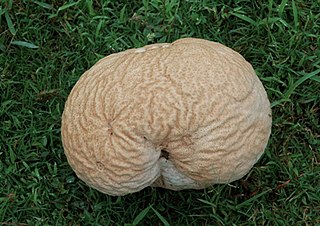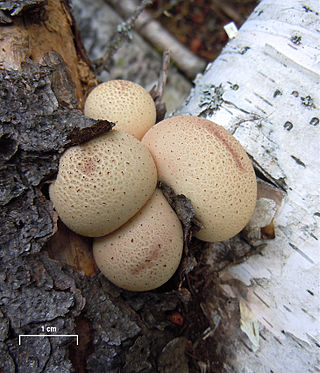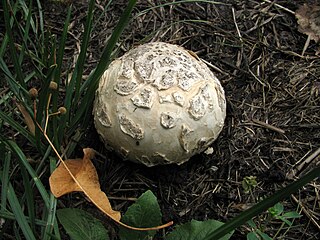
Puffballs are a type of fungus featuring a ball-shaped fruit body that bursts on contact or impact, releasing a cloud of dust-like spores into the surrounding area. Puffballs belong to the division Basidiomycota and encompass several genera, including Calvatia, Calbovista and Lycoperdon. The puffballs were previously treated as a taxonomic group called the Gasteromycetes or Gasteromycetidae, but they are now known to be a polyphyletic assemblage.

Lycoperdon is a genus of puffball mushrooms. The genus has a widespread distribution and contains about 50 species. In general, it contains the smaller species such as the pear-shaped puffball and the gem-studded puffball. It was formerly classified within the now-obsolete order Lycoperdales, as the type genus which, following a restructuring of fungal taxonomy brought about by molecular phylogeny, has been split. Lycoperdon is now placed in the family Agaricaceae of the order Agaricales.

Calvatia is a genus of puffball mushrooms that includes the spectacular giant puffball C. gigantea. It was formerly classified within the now-obsolete order Lycoperdales, which, following a restructuring of fungal taxonomy brought about by molecular phylogeny, has been split; the puffballs, Calvatia spp. are now placed in the family Agaricaceae of the order Agaricales.

Lycoperdon perlatum, popularly known as the common puffball, warted puffball, gem-studded puffball or devil's snuff-box, is a species of puffball fungus in the family Agaricaceae. A widespread species with a cosmopolitan distribution, it is a medium-sized puffball with a round fruit body tapering to a wide stalk, and dimensions of 1.5 to 6 cm wide by 3 to 10 cm tall. It is off-white with a top covered in short spiny bumps or "jewels", which are easily rubbed off to leave a netlike pattern on the surface. When mature it becomes brown, and a hole in the top opens to release spores in a burst when the body is compressed by touch or falling raindrops.

Lycoperdon umbrinum, commonly known as the umber-brown puffball, is a type of Puffball mushroom in the genus Lycoperdon. It is found in China, Europe, Africa, and North America.

Calvatia craniiformis, commonly known as the brain puffball or the skull-shaped puffball, is a species of puffball fungus in the family Agaricaceae. It is found in Asia, Australia, and North America, where it grows on the ground in open woods. Its name, derived from the same Latin root as cranium, alludes to its resemblance to an animal's brain. The skull-shaped fruit body is 8–20 cm (3–8 in) broad by 6–20 cm (2–8 in) tall and white to tan. Initially smooth, the skin (peridium) develops wrinkles and folds as it matures, cracking and flaking with age. The peridium eventually sloughs away, exposing a powdery yellow-brown to greenish-yellow spore mass. The puffball is edible when the gleba is still white and firm, before it matures to become yellow-brown and powdery. Mature specimens have been used in the traditional or folk medicines of China, Japan, and the Ojibwe as a hemostatic or wound dressing agent. Several bioactive compounds have been isolated and identified from the brain puffball.

Apioperdon pyriforme commonly known as the pear-shaped puffball or stump puffball, is a saprobic fungus present throughout much of the world. Emerging in autumn, this puffball is common and abundant on decaying logs of both deciduous and coniferous wood. It is considered a choice edible when still immature and the inner flesh is white. It is often called Lycoperdon pyriforme, but was transferred to Apioperdon in 2017 based on phylogenetic and morphological differences. It is the only species in the genus.

Bovista is a genus of fungi commonly known as the true puffballs. It was formerly classified within the now-obsolete order Lycoperdales, which, following a restructuring of fungal taxonomy brought about by molecular phylogeny, has been split; the species of Bovista are now placed in the family Agaricaceae of the order Agaricales. Bovista species have a collectively widespread distribution, and are found largely in temperate regions of the world. Various species have historically been used in homeopathic preparations.

Bovista dermoxantha is a small, white, nearly round puffball, recognized when young by a cottony-felty outer surface that becomes inconspicuously warted, eventually leaving fine, pallid, scales on an ochre to brown endoperidium. Bovista plumbea is similar, but has a smoother surface when young, and lacks a basal mycelial cord. In age it is distinguished by a dull greyish endoperidium. Large specimens of Bovista dermoxantha may also be mistaken for Bovista pila. Both have a mycelial cord attachment to the substrate, but Bovista pila differs in releasing spores through tears or splits in the endoperidium rather than by an apical pore.

Handkea utriformis, synonymous with Lycoperdon utriforme, Lycoperdon caelatum or Calvatia utriformis, is a species of the puffball family Lycoperdaceae. A rather large mushroom, it may reach dimensions of up to 25 cm (10 in) broad by 20 cm (8 in) tall. It is commonly known as the mosaic puffball, a reference to the polygonal-shaped segments the outer surface of the fruiting body develops as it matures. Widespread in northern temperate zones, it is found frequently on pastures and sandy heaths, and is edible when young. H. utriformis has antibiotic activity against a number of bacteria, and can bioaccumulate the trace metals copper and zinc to relatively high concentrations.

Handkea is a genus of puffball mushrooms in the family Agaricaceae. In 1989, German mycologist Hanns Kreisel described the genus Handkea to include species of Calvatia with distinct microscopic features, including a unique type of capillitium, with curvy slits instead of the usual pores. Although accepted by some authors, the genus concept has been rejected by others.

Calvatia sculpta, commonly known as the sculpted puffball, the sculptured puffball, the pyramid puffball, and the Sierran puffball, is a species of puffball fungus in the family Agaricaceae. Attaining dimensions of up to 8 to 15 cm tall by 8 to 10 cm wide, the pear- or egg-shaped puffball is readily recognizable because of the large pyramidal or polygonal warts covering its surface. It is edible when young, before the spores inside the fruit body disintegrate into a brownish powder. The spores are roughly spherical, and have wart-like projections on their surfaces.

Mycenastrum is a fungal genus in the family Agaricaceae. The genus is monotypic, containing one widely distributed species, Mycenastrum corium, known by various common names: the giant pasture puffball, leathery puffball, or tough puffball. The roughly spherical to turnip-shaped puffball-like fruit bodies grow to a diameter of 6–24 cm (2–9 in). Initially covered by a thick, felted, whitish layer, the puffballs develop a characteristic checkered skin (peridium) in age. When the internal spore mass, the gleba, is firm and white, the puffball is edible, although some individuals may suffer mild gastrointestinal symptoms after eating it. As the spores mature, the gleba turns first yellowish then purplish brown. Spores are released when the peridium eventually splits open into irregularly shaped sections. Microscopically, the gleba consists of spherical, dark brown spores with rounded bumps on their surfaces, and a capillitium—intricately branched fibers that form long thorn-like spines. The puffball grows on or in the ground in prairie or desert habitats. Although widely distributed, it is not commonly encountered. Mycenastrum corium is a threatened species in Europe.

Lycoperdon echinatum, commonly known as the spiny puffball or the spring puffball, is a type of puffball mushroom in the family Agaricaceae. The saprobic species has been found in Africa, Europe, Central America, and North America, where it grows on soil in deciduous woods, glades, and pastures. It has been proposed that North American specimens be considered a separate species, Lycoperdon americanum, but this suggestion has not been followed by most authors. Molecular analysis indicates that L. echinatum is closely related to the puffball genus Handkea.

Lycoperdon pulcherrimum is a type of puffball mushroom in the genus Lycoperdon. It was first described scientifically in 1873 by Miles Joseph Berkeley and Moses Ashley Curtis. The fungus is found in the southern United States.
Lycoperdon radicatum is a species of puffball mushroom in the family Agaricaceae. It was described in 1848 by French botanists Michel Charles Durieu de Maisonneuve and Camille Montagne. It is nonpoisonous.

Lycoperdon molle, commonly known as the smooth puffball or the soft puffball, is a type of puffball mushroom in the genus Lycoperdon. It was first described scientifically in 1799 by Dutch mycologist Christiaan Hendrik Persoon. The puffball is edible when the internal flesh is still white.

Handkea excipuliformis, commonly known as the pestle puffball or long-stemmed puffball, is a species of the family Agaricaceae. A rather large puffball, it may reach dimensions of up to 15 cm (5.9 in) broad by 25 cm (9.8 in) tall. Widespread in northern temperate zones, it is found frequently on pastures and sandy heaths.

Lycoperdon marginatum, commonly known as the peeling puffball, is a type of puffball mushroom in the genus Lycoperdon. A common species, it is found in Europe and North America, where it grows on the ground. It is characterized by the way that the spiny outer layer peels off in sheets.

Bovista pila, commonly known as the tumbling puffball, is a species of puffball fungus in the family Agaricaceae. A temperate species, it is widely distributed in North America, where it grows on the ground on road sides, in pastures, grassy areas, and open woods. There are few well-documented occurrences of B. pila outside North America. B. pila closely resembles the European B. nigrescens, from which it can be reliably distinguished only by microscopic characteristics.
















